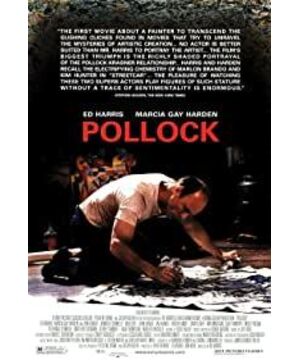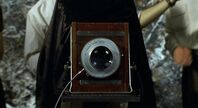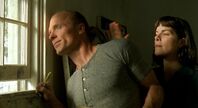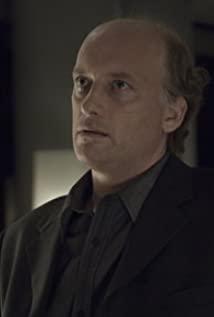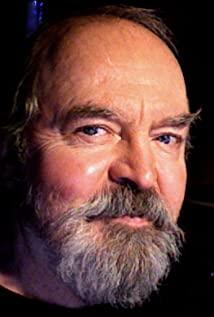Pollock (born 1912-1956 in Gary, Indiana, USA) was the first American abstract painter to be noticed by Europe. He changed the role of the United States as a follower of European art from the European Renaissance to the mid-20th century. He overthrew the United States. Has always adhered to the figurative language of painting. He created the world-famous "drip painting" and became a classic work of abstract expressionism.
Of course, the prosperity of American contemporary art cannot be separated from the soil laid by the US military, technology, economy, and politics after World War II, and it cannot be separated from the strong economy that attracts capital, many immigrant artists and art institutions. But the reason why Pollock can become a typical representative of American abstract expressionism is due to his artistic life driven by inner creativity and destructive power alternately.
Pollock, he is deep, he is crazy, he is cowardly, he is irritable, he is such a divided existence, his self-doubt makes his artistic career often on the verge of destruction, and his self-riding allows his creativity to derive magical works. Pollock put his emotions into his paintings and managed to escape the skill requirements of art. In the end, his persistent struggle and getting rid of made him stand out and was pushed to the position of "the greatest painter" by the times, but it also pushed him to the end of destruction.
When Pollock was 9 years old, his father ran away from home and grew up with his indifferent and controlling mother and his cowardly brother. In 1929, Pollock attended the Art Students League of New York and studied under Benton. After graduation, he participated in the federal government. The work of art planning began with nearly a decade of experience as an art student who was economically poor and underwhelmed in his career. Pollock drank and drunk to escape all the unsatisfactory numbness of life, so that his brother and sister-in-law who lived together could not bear his violent attack after being drunk.
In 1941, when Pollock was about to be rejected by his brother and sister-in-law, a strong and talented Russian Jewish immigrant woman appeared. She was the painter Lee Krasner. Her great dedication provided Pollock with a harbor of soul, a rudder of career and a guarantee of life. But she couldn't change it, or it could be said that it catalyzed Pollock's tragic ending. The film "Pollock" started from the year when Lee Krasner walked into Pollock's life. Focusing on the contradictory marriage of Pollock and Lee Krasner, the triumph, fall, and destruction that this marriage brought to Pollock's art and life are used to connect the main people and events in Pollock's life:
1. The woman behind
In the film, Lee Krasner wearing a red coat and Pollock wearing a black top hat and coat of the same color are walking on the street in sharp contrast. One is enthusiastic and the other is deep and low-key, both conflicting and extraordinarily tuned. This was the third week after Lee Krasner visited the paintings in Pollock's house. The embarrassed Pollock went to the appointment to visit Lee Krasner's studio at 23 Nishikujo, New York.
Lee Krasner is an avant-garde female painter who abandoned concrete early and expressed her feelings in abstract forms. She admired the innocence of the "psychic" poet Rimbaud's mission and the pure wild state without being contaminated with secular meaning. When she saw Pollock's paintings, she saw the burst of emotions of colors and lines. She really knew Pollock, she wanted to be Pollock's muse and the person who supported him on the altar.
After Pollock's brother and sister-in-law moved away, Lee Krasner officially began to take care of Pollock's life and take care of all Pollock's art promotion affairs. This avant-garde female painter who didn't even make coffee by herself before, transformed into Pollock's agent, secretary, nanny, and wife step by step.
During this period, Lee Krasner actively used his contacts to contact art collectors and art critics, and tried every means to recommend Pollock's works to New York. Pollock either created it in a small room or dissed his contemporaries in the bar to release his unwilling depression.
At this time Pollock insisted on himself. He was dissatisfied with the artistic style of others: "The abstract painter Gorky is a ruminating cow, the abstract painter Franz Klein is a prostitute, Picasso is an outdated painter, and the new action painter De Kooning is okay. Still exploring". Faced with Lee Krasner's view that "you can't abstract for abstraction, abstraction must have realistic roots and rely on nature", he insisted: "I am nature."
2. Boom
Under the positive recommendation of Lee Krasner and the introduction of friends, Pollock's cottage welcomed his Bole, Howard Putzer, the working partner of the famous art collector Peggy Guggenheim. Howard Putzer admired "genius" after seeing Pollock's paintings. Under the recommendation of Pollock, Peggy Guggenheim decided to visit Pollock at the recommendation of Howard Putzer.
In the film, when Lee Krasner ran home with a drunk Pollock and bumped into an angry art collector Peggy Guggenheim at the door, he couldn't help but sweat for Pollock. Fortunately, Peggy Guggenheim climbed back into Pollock's house. Peggy Guggenheim disappeared when she saw the paintings. The paintings she saw were different from the same surrealist style of her painters. Pollock finally won his first solo exhibition (Modern Gallery on November 7, 1943), and he received a monthly allowance of $150 from Peggy.
The painting exhibition is up, but for Pollock it is more like opening his comfort zone and accepting the embarrassment of outsiders' guidance. Like all creators, on the one hand, they hope that their works will stick to their uniqueness, and on the other hand, they hope that the public can recognize their own style. This kind of open experience made Pollock nervous and anxious, especially in the face of the art critic Clem and the newspaper's comments, Pollock was very concerned, and did not sell a painting in the exhibition, which made Pollock begin to examine ,self suspect.
In order to complete the mural of Peggy's Villa, Pollock opened up the house and made a large drawing board. When he wandered around the white canvas, the big shadow on the canvas faced him, just as his lonely, hesitant, and huge desires were thrown into the canvas without reservation, but it was difficult to make it clear. He looked at the drawing board for several weeks in a daze and was unable to write. Finally stepped on a cigarette, with his creative determination. His painting method at this time is full of emotional layers of superposition and integration: the catharsis of long straight lines, the struggle of vortex curves, the flooding of blocky colors, the unruly color splashing, the entanglement of white harmony...When Li saw the essence Exhausted, as if hollowed out, Pollock ran to look at the painting excitedly. Pollock reproduced the self-soul vortex painting. Her smile knew that there was no need to explain, and Pollock's mural was successful.
3. Self-doubt
After the exhibition, the pain of long-term self-doubt has killed and awakened Pollock time and time again. Alcohol cannot make him no longer suffering, but he can only escape temporarily. After waking up, I don’t know whether to be fortunate or regretful, and his heart is fragile. , Any little stimulation will make it collapse. After falling drunk outside and waking up again, Pollock knocked on the door and said to the worried Lee: "I'm fed up, help me."
In order for Pollock to adjust their mood, Lee and Pollock came to live in the small town of Springs on Long Island after their marriage. The country folks are warm and friendly, cute wild animals, blue sky and white clouds, fields and rivers. Everything that is beautiful seems to be healing Pollock. He began to concentrate on creating and even occasionally enjoy the fun of farming. Li accompanied him while secretly rejecting his friends. She hoped that Pollock would devote herself to creation. When Pollock proposed to have a child, Li firmly opposed. She believed that as a genius painter, having a child was an obstacle to career. This allowed Pollock to understand what Lee was expecting from him, which undoubtedly brought pressure on Pollock.
The film used art collector Peggy, critic Clem and others to have a dinner with Pollock's family, depicting Pollock's uncertainty about his own works of art at that time. The critic Kerim said to Pollock: "You are back to the image. Color is color, and plane is plane. There should be no other meaning. Surrealism confuses painting with writing." Pollock felt uneasy. He moved the easel out to revise it almost immediately, but he couldn't make a pen. Everyone was surprised. Clem hurriedly explained: "This is your art. It doesn't matter how others feel. You can't ruin your art."
4. Break through the old and bring forth the new
Such a countryside In January 1947, the market of Pollock's works was not optimistic, and it was almost impossible to sustain their livelihood.
In 1947, when Pollock was painting, he tried to use this method to paint the pattern left by the dripping paint on the floor. He first nailed the canvas to the floor or wall, and then sprinkled paint on the canvas at will, allowing it to drip on the canvas, creating a crisscross effect of abstract lines. Pollock sometimes rubbed stones, sand, iron nails, and broken glass mixed with paint on the canvas. He abandoned the painting tools commonly used by painters, and completely got rid of the traditional mode of being restricted by wrists, elbows and shoulders, and acted improvisationally and casually. This method is called action painting or abstract expressionism.
When Li Krasner saw Pollock's dripping paintings, he said: "You succeeded, Pollock, break the old and bring forth the new."
From the dialogue between Pollock and the critic Clem, we can understand that Pollock was distressed at this time with a livelihood that was about to be unsustainable.
Pollock: "No one knows my existence, who will talk about me? You are the only one, Clem. What use does your praise do to me?"
Clem: "Pollock, this is a new thing, you have to give it time."
Pollock: "We have no money. I go to the beach every day to dig clams with my toes."
Clem: "The United States has become the center of Western culture. What you are doing now is the most original and vibrant art in the entire United States. Sooner or later other critics will realize that you just have to persist."
Soon Pollock accepted an interview with "LIFE" magazine, and he responded to many doubts: "Forget about everything simply looking at the picture, like looking at the sheets full of flowers, don't worry about the meaning of the work."
In November 1949, as Clem said, Pollock's name became known to the public. He sold 25 of his 30 works in the autumn solo exhibition, and he succeeded.
Some people question the difficulty of controlling the fluidity of liquid pigments. Pollock replied, "I never use chance." In fact, Pollock's drip painting is really not that simple. In 1999, physicist and artist Charlie Taylor used computer analysis to show the similarities between Pollock's drawings and the fractal forms found in nature. This confirms Pollock's own words "I am nature". Cognitive neuroscientists have proved that Pollock’s fractals cause the same stress-reducing effect in the viewer as computer-generated fractals and natural fractals.
5. Self-destruction
But this decompression didn't work on Pollock himself. When he became famous, he accepted the job of recording painting films, but the filming and filming of his painting process out of context and artistic processing made Pollock feel that he was a liar. In the middle, Li advised Pollock not to force himself to shoot, as long as he concentrates on painting. But Pollock thought it was impolite to stop. In pain, Pollock, who had been abstaining from drinking for two years, raised his glass again.
At this time, Pollock's spirit had gone wrong, and a little stimulus would evoke the uncontrolled beasts in his body. The film uses Pollock's plot to look at Lee Krasner to reflect Pollock's unstable state. What he saw was Lee Krasner's smiling eyes full of worry and fear.
The rise of the painter Clifford Steele made Pollock once again anxious. Faced with Pollock’s hysteria, Lee wanted him to stop the glass and pick up the paintbrush. Pollock thought it was a huge pressure on him, and the two argued. Continuously. Pollock began to cheat. He and his long-time lover Ruth Krigman were almost openly together, and he himself didn't know whether he loved Lee Krasner or Ruth Krigman. He was able to relax with Ruth Krigman, and his life lost support without Lee Krasner. Facing Pollock's derailment, Li was angry and traveled to Europe silently, silently enduring it.
In 1956, in a car accident, the 44-year-old Pollock completed a short life. Suddenly remembered the first line of Rimbaud’s poem that Pollock saw in Lee Krasner’s studio in New York: “Go all! March, burden, desert, worry and anger.” Pollock finally ended him with destruction. All the pain.
It is also a painter’s film, and it also has artistic rationality and even an embarrassing life that is not understood by the world. But unlike the romance and melancholy of European painter films, "Pollock" appears gloomy and dull. After watching it, I feel that the emotions are still in the film. In, a different experience.
View more about Pollock reviews


